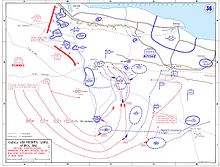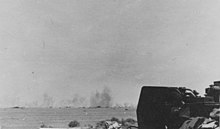Battle of Bir Hakeim
| date | May 26 to June 11, 1942 |
|---|---|
| place | Bir Hakeim , Libya |
| output | Outbreak of the Free French, conquest by German-Italian forces. |
| consequences | German-Italian advance slowed, but the axis was able to advance as far as El-Alamein. |
| Parties to the conflict | |
|---|---|
| Commander | |
| Troop strength | |
| 45,000 total strength of the Axis troops
Troops with direct involvement: 800–1000 |
3703 |
The Battle of Bir Hakeim (according to Italian phonetics Bir Hacheim , Arabic. بئر حكيم) took place during the Second World War from May 26 to June 11, 1942 in Libya during the German campaign in Africa. In the course of the Theseus operation , a brigade of the Forces françaises libres held up the advance of the German troops at the desert oasis Bir Hakeim for over two weeks.
Starting position
Bir Hakeim was part of the extensive belt of defensive positions (so-called boxes) that the Allies had put on to ward off an enemy advance. Each of these so-called boxes on the Gazala Line was secured by an Allied brigade . The box of the Free French was built as the southernmost point of the line around a dry oasis and an abandoned fort. The French brigade consisted of two battalions of the Foreign Legion , and one battalion each of marine infantry , naval fusiliers , central African colonial infantry and Pacific colonial infantry .
On May 26, 1942, Colonel General Erwin Rommel started the Theseus company in the Kyrenaica with the aim of conquering Tobruk and El Alamein . At the beginning of the offensive, the Allied troops were defeated in the middle of the Gazala line and forced to retreat. Only the boxes Bir Hakeim and Ualeb held up there.
course
Rommel let the engineer battalions 33, 200 and 900 attack through the minefields between Ualeb and Bir Hacheim from north to south. On June 8th the pioneers were about 6 km from Bir Hacheim. Rommel strengthened the combat force under the command of Colonel Hecker with the Gebirgsjägerkompanie, the Panzerjägerkompanie and the reconnaissance platoon of the Special Unit 288, also with parts of the Kiehl Combat Squadron. By evening the fighting force fought their way up to 500 m from the fortress. During the night it was possible to occupy machine gun positions. The fight continued on June 9th. On the evening of June 10th, the Hecker fighting force had broken into their positions so far that the Allies tried to break out.
Under cover of darkness, the French troops broke out of the fort on the night of June 11th and fought their way to the British lines, losing 500 men. These attempts to break out ended with heavy losses for both sides and with success for the French. When the Germans took the position the next morning, 500 wounded were taken prisoner.
consequences
During the fighting for Bir Hakeim, parts of the 8th Army were able to carry out an orderly retreat. By bypassing the Gazala position with the mobile units, however, Rommel cut off a British infantry division. This received the order from Cairo to break out. With the direct route of retreat cut off, the division broke out to the west, through the lines of the Axis powers. Large parts of the division were taken prisoner and the British defense in the Tobruk area was missing. Tobruk was captured by the German Africa Corps. An important supply port for the Allies was lost. Only at El Alamein could Rommel's advance be brought to a halt.
Role in the culture of remembrance
Even if the battle was ultimately just an episode of the war in North Africa, it is seen in France as the beginning of the restoration of the country's military honor after the defeat of 1940 . It was highlighted in the Free French propaganda, but also in the German and contributed to the emergence of the "Gaullist myth".
In Paris, the “Bir-Hakeim” metro station and the Pont de Bir-Hakeim bridge on the Seine commemorate the battle. The Musée de l'armée in the Invalides also pays tribute to the battle with an exhibition. A group of maquisards in the Cevennes had the name Bir Hakeim as early as the Second World War .
See also
literature
- Raymond Cartier : The Second World War , Munich 1985, Volume 1, p. 461 ff.
- Daniel Rondeau and Roger Stéphane: Des hommes libres - La France libre par ceux qui l'ont faite , Éditions Bernard Grasset, Paris, 1997, p. 243 ff.
- Félix de Grand'Combe: Bir-Hakeim , Presses Universitaires de France, 1945.
- Marie-Pierre Kœnig : Bir-Hakeim , Office français d'édition, 1945.
- Vers .: Bir Hakeim, 10 June 1942 , Editions Robert Laffont, Paris 1971.
- Pierre Messmer : "La bataille de Bir Hakeim", Espoir , revue de la Fondation Charles de Gaulle, Paris, September 1986.
- Jacques Mordal: Bir-Hakeim , Éditions Amiot-Dumont, 1962.
- Raphaël Onana: Un homme blindé à Bir-Hakeim , récit d'un sous-officier Camerounais qui a fait la guerre de 1939–1945, Éditions L'Harmattan.
- Bernard Saint-Hillier: "La bataille de Bir-Hakeim" , Revue de la France Libre , 1987.
- Erwan Bergot : La Légion au combat, Narvik, Bir-Hakeim, Dièn Bièn Phu , Presses de la Cité, 1975.
- Vers .: Bir-Hakeim , Presses de la Cité, 1989.
- François Broche: Bir Hakeim, La France renaissante , Éditions Italiques, 2003.
- Ders .: Bir Hakeim, mai-juin 1942 , Perrin, 2008 ( review on histobiblio.com ).
- Jean-Louis Crémieux-Brilhac : La France Libre , Gallimard, Paris, 1996.
- Dominique Lormier: Rommel - La fin d'un mythe , Le Cherche midi, Paris, 2003.
- Susan Travers : Tant que dure le jour (German edition: A woman among men , Ullstein Verlag 2003, ISBN 3-548-36381-4 )
Web links
- The Battle of Bir Hakeim on the Chemins de Mémoire side of the French Ministry of Defense
Individual evidence
- ↑ Gazala 1942 Rommel's Greatest Victory Ken Ford, 2008
- ↑ The Second World War: Texts - Images - Maps - Documents - Chronicle , Christian Zentner , Munich 1985, p. 313
- ^ Edward L. Bimberg: Tricolor over the Sahara: The desert battles of the Free French, 1940-1942 , Greenwood Publishing Group, 2002
- ↑ Paul Carell , The Desert Foxes. With Rommel in Africa . 1964, most recent edition 2003.
- ^ Matthias Waechter: The Myth of Gaullism: Hero Cult, History Politics and Ideology 1940 to 1958 , Wallstein Verlag, 2006
- ↑ Paul Carell: The Desert Foxes .
- ↑ Matthias Waechter: The Myth of Gaullism. Hero cult, historical politics and ideology 1940–1958 , pp. 101ff, Göttingen, Wallstein-Verlag, 2006
Coordinates: 31 ° 35 ′ 37.93 " N , 23 ° 28 ′ 47.16" E



